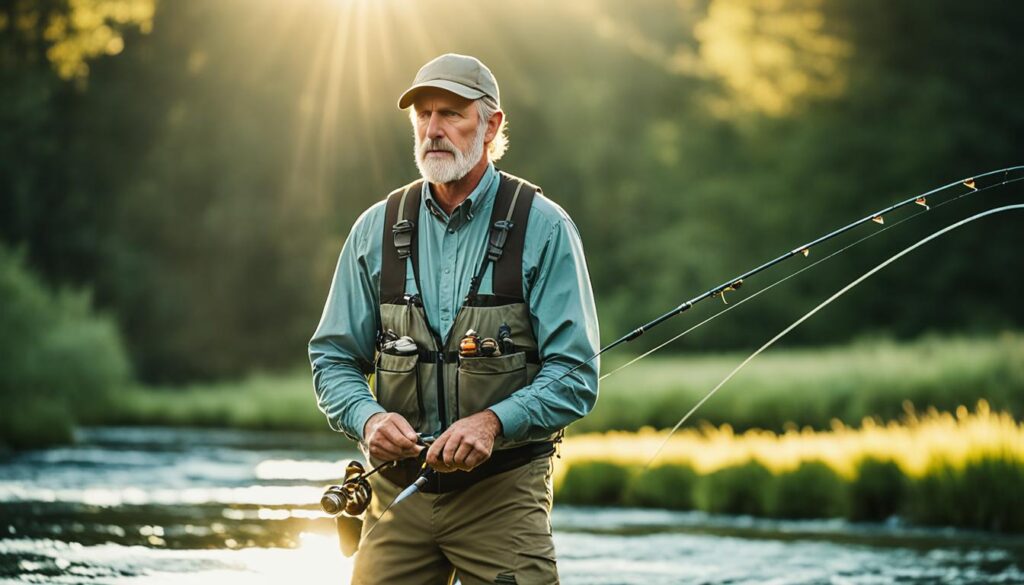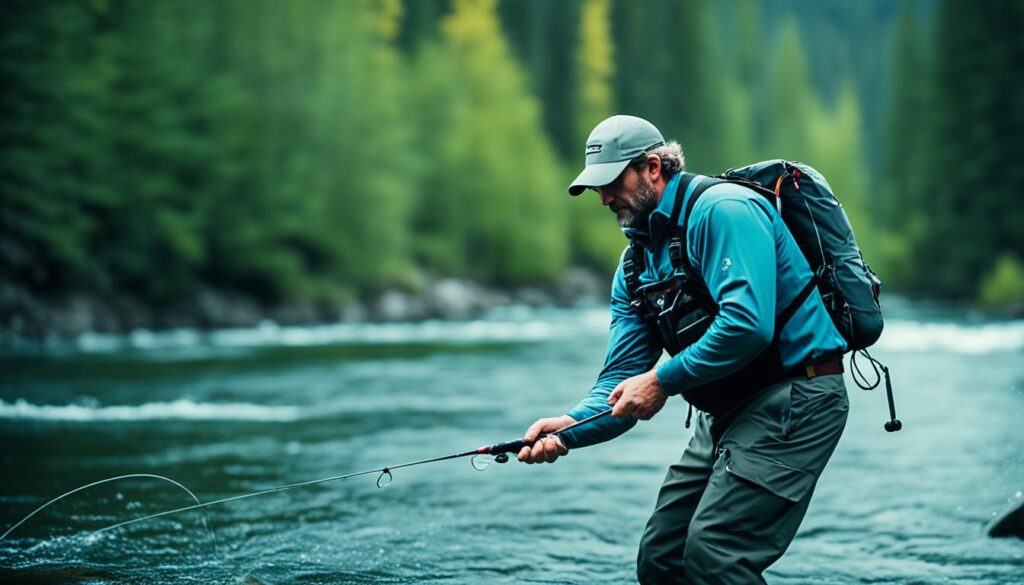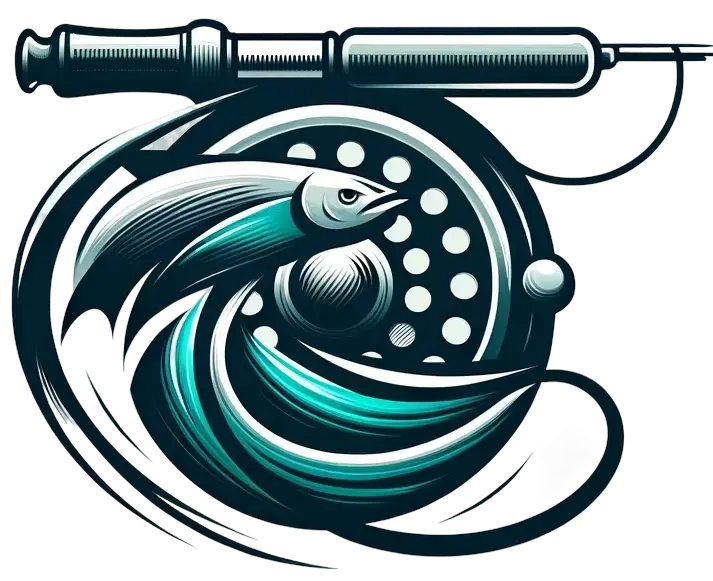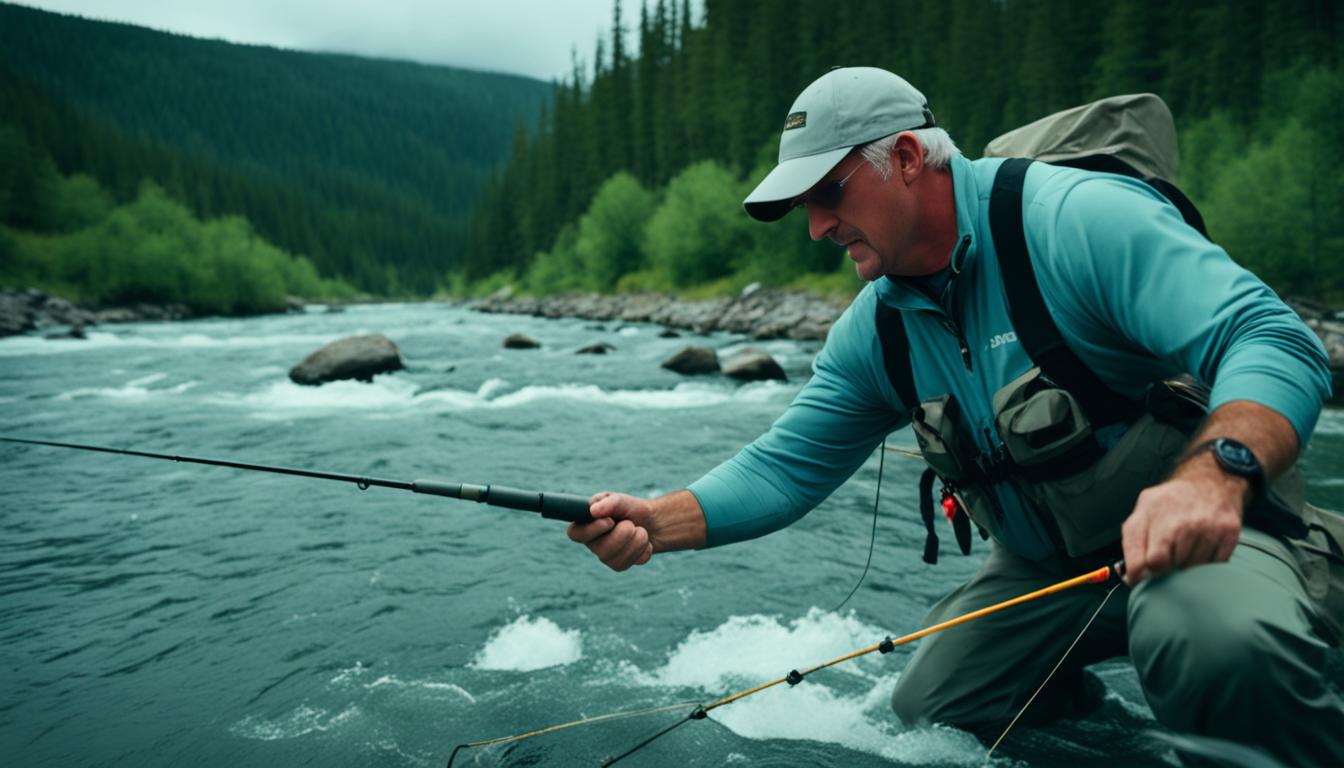Welcome to our comprehensive guide on troubleshooting common fly fishing problems. Whether you’re a seasoned angler or just starting out, we understand that fly fishing can sometimes have its challenges. That’s why we’re here to help you overcome those hurdles and improve your overall fly fishing experience. In this guide, we will provide you with practical tips and techniques for resolving issues such as line tangles, backcast problems, rod repair, reel problems, and fly selection strategies. So, let’s dive in and start troubleshooting!
Key Takeaways:
- Troubleshoot common fly fishing problems to improve your fishing experience
- Learn techniques for resolving line tangles, backcast problems, rod repair, reel problems, and fly selection
- Apply practical tips and strategies for better fly fishing results
- Enhance your fly fishing skills through troubleshooting and maintenance
- Share your experiences and challenges in the comments
Starting with the Right Foot: Common Mistakes to Avoid
When it comes to fly fishing, getting off to a good start is crucial. However, many anglers unknowingly make common mistakes that can hinder their casting technique and overall success on the water.
In this section, we will address three key mistakes that anglers often make at the beginning of a fly cast: starting with too much slack line, having the rod tip too high, and ripping instead of pulling the line off the water. By avoiding these errors and following our tips and advice, you can ensure a smooth and effective cast right from the beginning.
Starting Fly Cast with Too Much Slack Line
One common mistake is starting the fly cast with too much slack line. This can lead to a loss of accuracy and control, making it difficult to deliver the fly precisely where you want it.
To avoid this, be sure to strip in any excess line before you start your cast. This will help ensure that you have a tight connection between the fly line and the rod, allowing for a more accurate and controlled cast.
Having the Rod Tip Too High
Another mistake anglers often make is having the rod tip too high at the start of the cast. This can result in a loss of power and distance, as well as a higher risk of the line collapsing or tangling.
When initiating the cast, keep your rod tip low and close to the water. This will allow for a more efficient transfer of energy and help maintain a straight line path for the fly line.
Ripping Instead of Pulling the Line off the Water
One mistake that can greatly affect the effectiveness of your cast is ripping the line off the water instead of smoothly pulling it. This sudden jerking motion not only disrupts the line’s momentum but also increases the chances of line tangles and knots.
Instead, focus on pulling the line gradually and smoothly. This will help maintain control and prevent unnecessary disturbances on the water’s surface, improving the accuracy and presentation of your fly.
By addressing and avoiding these common mistakes, you can set yourself up for a successful fly cast right from the start. Remember to strip in any excess line, keep the rod tip low, and pull the line off the water smoothly to achieve better accuracy, distance, and overall fly fishing performance.
| Common Mistakes to Avoid | Effects | Tips and Advice |
|---|---|---|
| Starting with Too Much Slack Line | Loss of accuracy and control | Strip in excess line before casting |
| Having the Rod Tip Too High | Loss of power and distance, increased risk of line collapse and tangling | Keep the rod tip low at the start of the cast |
| Ripping Instead of Pulling the Line off the Water | Disrupted line momentum, increased risk of line tangles and knots | Pull the line off the water smoothly and gradually |
Mastering the Backcast: Key Techniques for Success
In fly fishing, the backcast is an essential skill that sets the stage for a successful cast. However, many anglers struggle with common mistakes that hinder their casting ability. In this section, we will explore key techniques for mastering the backcast, focusing on overcoming three common challenges: stopping in the backcast, rushing the backcast, and forward creep.
Stopping in Backcast
One frequent mistake anglers make is failing to stop the rod on the backcast. This hinders the energy transfer, resulting in a weak forward cast. To address this, it is crucial to develop a smooth casting stroke and practice the proper timing.
Remember, when executing the backcast, feel the rod loading and come to a definitive stop just before the line unfurls behind you. This pause allows the line to straighten out fully and prepares it for a powerful forward cast.
Rushing the Backcast
Another common obstacle is rushing the backcast. Impatience in the casting stroke can cause the line to tangle or result in inaccurate casts. To avoid this, it’s important to maintain a controlled tempo throughout the casting motion.
Take your time and allow the line to fully extend before initiating the forward cast. By slowing down and focusing on a deliberate backcast, you can achieve better accuracy and avoid unnecessary tangles.
Forward Creep
Forward creep, or the premature movement of the rod during the backcast, can lead to a lack of line control and compromised accuracy. To overcome this challenge, it’s crucial to maintain proper rod position throughout the backcast and avoid any unintended forward movement.
Keep your rod hand stable and resist the temptation to initiate the forward cast before completing the backcast. By maintaining a firm grip and a disciplined technique, you can eliminate forward creep and improve your overall casting performance.
By addressing these common challenges and applying the techniques outlined above, you’ll be well on your way to mastering the backcast. Remember, practice makes perfect, so spend time honing your skills on the water and incorporating these techniques into your casting routine.

In the next section, we will shift our focus to perfecting the forward cast and provide tips for achieving accuracy and power.
Perfecting the Forward Cast: Tips for Accuracy and Power
In order to become a proficient fly fisherman, it’s crucial to master the art of the forward cast. This fundamental technique allows you to accurately place your fly on the water and generate the power needed for successful fishing. However, there are common challenges that can hinder the effectiveness of your forward cast. Let’s explore some tips and techniques to overcome these obstacles and improve your casting ability.
Breaking the Wrist
One of the most common mistakes anglers make during the forward cast is breaking the wrist. This unintended movement can result in a loss of power, accuracy, and control. To avoid this, keep your wrist firm and straight throughout the casting motion. Allow the power to come from your forearm and shoulder, creating a smooth and efficient casting stroke.
Using Too Much Muscle
While it may be tempting to rely on brute force, using too much muscle can actually hinder your casting performance. Overpowering the cast can lead to erratic and inaccurate presentations. Instead, focus on utilizing a fluid and relaxed casting motion. By harnessing the energy and momentum of the rod, you’ll achieve better accuracy and conserve your energy for prolonged fishing sessions.
Performing Too Many False Casts
False casting is a valuable technique for adjusting distance and line control. However, excessive false casts can impede your casting efficiency and result in missed opportunities on the water. Aim to minimize unnecessary false casts by practicing your timing and mastering your line control. With experience, you’ll learn to efficiently generate line speed and make fewer casts to achieve the same desired result.
By addressing these common challenges head-on, you’ll be well on your way to perfecting your forward cast. Practice these techniques regularly and pay attention to your form and technique. As with any skill, the more you practice, the more natural and effortless your forward cast will become.
This image showcases the proper wrist position and fluid casting motion necessary for a successful forward cast.
Fly Line Management: Controlling the Line for Better Results
In order to achieve better results in your fly fishing casting, it is crucial to master the art of fly line management. Poor line control can lead to numerous problems and hinder your ability to make accurate and efficient casts. In this section, we will address key issues that can arise from improper line management, such as having too much slack line, starting with the rod tip too high, and ripping instead of pulling the line. By learning techniques and implementing effective strategies, you can take control of your fly line and improve your overall casting performance.
Too Much Slack Line
One common mistake that many fly fishermen make is having too much slack line between the rod tip and the fly. This can result in poor accuracy and a lack of control over the fly. When there is excessive slack, it becomes challenging to properly manipulate the line during the cast, leading to suboptimal results. To overcome this issue, it is essential to maintain tension in the line at all times. By keeping the line taut and minimizing slack, you will have better control and accuracy when presenting the fly to the target.
Starting with the Rod Tip Too High
The position of the rod tip at the beginning of the cast plays a crucial role in the success of your cast. Starting with the rod tip too high can lead to a loss of power, making it difficult to generate sufficient line speed and distance. It can also result in a downward trajectory of the fly, causing it to hit the water forcefully and spooking nearby fish. To avoid this problem, make sure to start your cast with the rod tip low to the water’s surface. This will allow for a smooth acceleration and a more efficient transfer of energy, resulting in a better presentation and improved casting performance.
Ripping Instead of Pulling
During the cast, it is essential to smoothly and consistently pull the line through the guides to propel the fly forward. However, some anglers tend to rip or snatch the line, which can disrupt the casting stroke and lead to a loss of control. This abrupt motion can cause the line to tangle or create a jerky presentation of the fly. To avoid this issue, focus on making a deliberate and fluid pulling motion with your line hand. By maintaining a smooth and controlled pulling action, you will achieve better line control and a more accurate cast.
To summarize, effective fly line management is a fundamental skill that can significantly impact your fly fishing success. Avoiding common mistakes such as having too much slack line, starting with the rod tip too high, and ripping instead of pulling the line will lead to improved casting accuracy and control. By implementing the techniques discussed in this section, you will be able to take control of your fly line and achieve better results on the water.

| Common Mistake | Consequence | Solution |
|---|---|---|
| Too much slack line | Poor accuracy, lack of control | Maintain tension in the line to minimize slack |
| Starting with the rod tip too high | Loss of power, downward trajectory of the fly | Start the cast with the rod tip low to the water |
| Ripping instead of pulling | Disrupted casting stroke, loss of control | Make a smooth and controlled pulling motion with the line hand |
Conclusion
Throughout this quick troubleshoot guide, we have explored various common fly fishing problems and provided valuable tips and techniques to overcome them. By troubleshooting these issues, you can enhance your overall fly fishing experience and achieve better results on the water.
From dealing with fly line tangles to addressing backcast issues and fly reel problems, we have covered a wide range of challenges that fly fishermen often encounter. By implementing the fly fishing tips and techniques discussed in this guide, you can fine-tune your skills and improve your casting accuracy, power, and line control.
Remember, regular fly fishing gear maintenance is crucial for optimal performance. By taking care of your fly rod and reel, you can extend their lifespan and prevent potential problems. Additionally, fly selection strategies play a key role in attracting and enticing fish, so it’s essential to choose the right flies for the conditions you’re fishing in.
We hope that this guide has provided you with actionable solutions to common fly fishing problems. Feel free to share your own experiences and challenges in the comments below. Happy fly fishing!
FAQ
What are some common fly fishing problems and how can I troubleshoot them?
Common fly fishing problems include line tangles, backcast issues, rod and reel problems, and difficulty in selecting the right fly. To troubleshoot these problems, make sure to properly maintain your gear, practice the correct casting techniques, and learn effective fly selection strategies.
How can I avoid common mistakes at the beginning of a fly cast?
To avoid common mistakes at the beginning of a fly cast, start with the right amount of slack line, keep your rod tip at the correct height, and focus on pulling the line off the water rather than ripping it. Practice these techniques to improve your cast.
What are some key techniques for a successful backcast?
Key techniques for a successful backcast include stopping at the right moment, avoiding rushing the backcast, and preventing forward creep. Practice these techniques to enhance your backcast and improve your overall casting performance.
How can I perfect my forward cast for accuracy and power?
To perfect your forward cast for accuracy and power, avoid breaking your wrist, refrain from using too much muscle, and minimize the number of false casts. Focus on proper form and technique to achieve better results in your forward cast.
What is the importance of fly line management in casting?
Fly line management plays a crucial role in casting. Avoid having too much slack line, start with your rod tip at an appropriate height, and pull the line instead of ripping it. These techniques will help you control the line for better casting performance.




